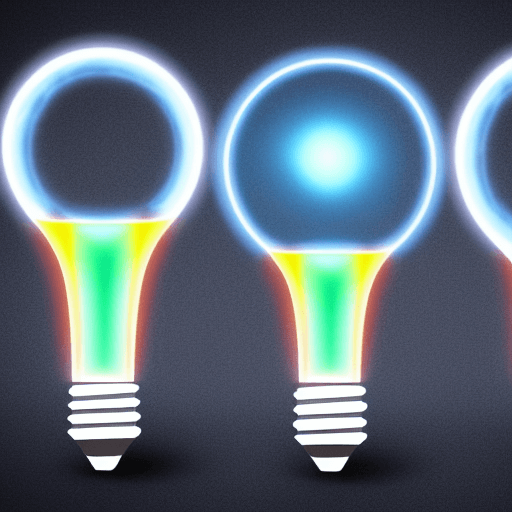Light Energy Examples
What are examples of light energy?
Light energy is a type of electromagnetic radiation that travels through the air and is visible to the human eye.
It is produced by the sun and other stars, and it can be used to power devices or light up spaces. Light energy is the form of energy that is used to power most life on Earth.

It is a type of electromagnetic radiation that travels through space as waves.
Let’s discuss some common examples of light energy in our lives.
Some examples of light energy include visible light, ultraviolet radiation, infrared radiation, and microwaves.
Here Is A List Of 7 Common Light Energy Examples:

- Sunlight – The light and warmth from the sun is a form of radiant energy generated by nuclear fusion reactions. Sunlight powers life through photosynthesis.
- Light bulbs – Incandescent, LED, and fluorescent light bulbs all work by converting electricity into visible light energy. This illuminates homes, offices, streets, etc.
- Lasers – Laser beams involve highly focused light energy, produced via stimulated emission and reflection within a “gain medium.” Lasers have many applications in science, medicine, industry, and entertainment.
- Bioluminescence – Some living organisms like fireflies, anglerfish, and deep sea creatures can generate their own light through chemical reactions. This light helps attract prey or mates.
- Auroras – Auroras like the northern and southern lights are natural light displays produced when solar wind particles interact with gases in the atmosphere. This excites the gases to emit colorful light.
- Lightning – The visible flash of lightning is an electric discharge generating brief but intense light energy through the air. This sudden electrostatic discharge heats the air into plasma.
- Fire – The visible flames and glow of fires come from blackbody radiation and the excitation of atoms releasing photons as light energy.
So in summary, light energy in its many forms – from sunlight to lasers to bioluminescence – arises from the electromagnetic radiation emitted when matter transitions to lower energy states.
Explain It To A Child
Light energy is all around us. The sun gives us light during the day, but we also get light from fire, lightning, and stars.

What is light energy?
Light energy is a type of electromagnetic radiation, which means it is made up of electric and magnetic fields that travel through the air at the speed of light.
It is this property that makes light so unique – it is the only known form of electromagnetic radiation that can travel through a vacuum.
This means that light does not need anything to travel through, unlike sound waves, which need air to travel.
- Light waves are also able to travel through other materials, like glass or water.
- When light waves hit an object, they can be reflected, refracted, or absorbed.
- Reflection occurs when light waves bounce off of a surface, like a mirror. Refraction occurs when light waves bend as they pass through a material like glass.
- And absorption occurs when light waves are taken in by an object and turned into other forms of energy, like heat.
All of these properties make light one of the most fascinating and important phenomena in the universe.
What are some light energy examples?

There are many examples of light energy.
The sun is the most obvious source of light energy, but it is not the only one. Other examples include fire, lightning, and stars.
Light energy is also present in our everyday lives, in the form of electric lights, computer screens, and televisions.
All of these things emit light that can be used to see or create things.

In addition, light energy can also be used to heat things up, as in the case of a light bulb. Finally, light energy can also be used to power some types of machinery, like solar panels.
The most common source of light energy
The most common source of light energy is the sun.

Sunlight is a combination of all the colors of the visible spectrum, and it is this variety of colors that makes sunlight so useful to us.
For example, when sunlight strikes a sheet of white paper, the paper reflects all of the colors equally, resulting in the appearance of a bright white. However, when sunlight strikes a sheet of black paper, the paper absorbs all of the colors, resulting in the appearance of a dark black.
- This absorption and reflection of light are how we see all the different colors around us.
- Sunlight is also the primary source of vitamin D for humans and other animals.
- This essential nutrient helps our bodies absorb calcium, which is necessary for strong bones and teeth.

In addition, vitamin D helps to regulate immune system function and cell growth. Without sunlight, we would not be able to survive.
How does light energy work?
When we think of light, we often think of the sun shining down on us or a lightbulb illuminating a dark room.
But what is light, really?
Light is a type of energy that travels through the air and is used to see things.
It is made up of tiny particles called photons.
Photons are like waves, and they vibrate at different frequencies. The frequency is what determines the color of light. For example, blue light has a higher frequency than red light.

Light energy can be used for many purposes, including powering solar panels and taking pictures.
It can also be harmful if we are exposed to too much of it, which is why we wear sunglasses to protect our eyes from the sun’s harsh rays.
What are some benefits of using light energy?
There are many benefits of using light energy.
- For one, light is a very efficient form of energy.
- It can be quickly converted into other forms of energy, such as heat or electricity.
- Additionally, light energy is very versatile.
- It can be used for a wide variety of applications, including lighting, powering electronics, and heating.
- Additionally, light energy is environmentally friendly. It does not produce pollution or other harmful emissions. Finally, light energy is renewable.

It can be generated from a number of sources, including solar power and wind power.
As a result, light energy is an attractive option for those looking for an efficient and eco-friendly form of energy.
How can we use light energy to power our lives?
Light energy is one of the most abundant resources on Earth.
Solar panels harness the power of the sun to generate electricity, while wind turbines use the kinetic energy of moving air to produce energy.
However, light energy can also be used to power our lives in other ways.
For example, laundry systems that use ultraviolet light to clean clothes require less water and detergent than traditional washing machines.
Similarly, LED bulbs are more efficient than incandescent bulbs, and they last longer as well.

By using light energy in more efficient ways, we can reduce our reliance on fossil fuels and help to preserve our planet for future generations.
So, as you can see, there are many examples of light energy all around us!
Article Sources
Jacks of Science sources the most authoritative, trustworthy, and highly recognized institutions for our article research. Learn more about our Editorial Teams process and diligence in verifying the accuracy of every article we publish.